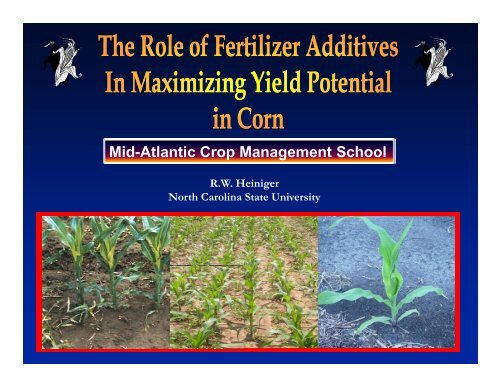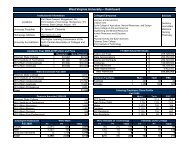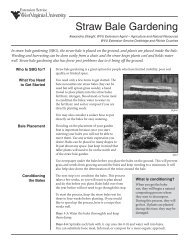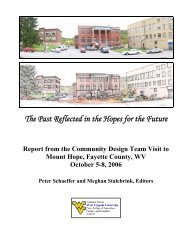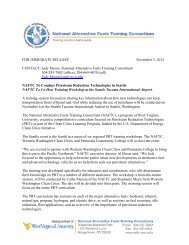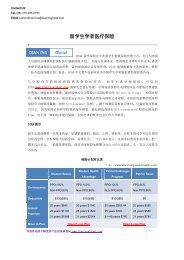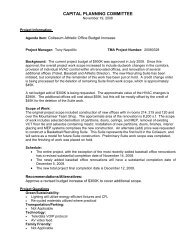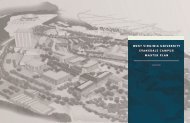nc state
nc state
nc state
You also want an ePaper? Increase the reach of your titles
YUMPU automatically turns print PDFs into web optimized ePapers that Google loves.
Mid-Atlantic Crop Management School<br />
R.W. Heiniger<br />
North Carolina State University
NC STATE UNIVERSITY
(lb)<br />
Applied<br />
Corrn<br />
Yield ( bu) or N<br />
Pasquotank Corn – 1998 to 2007<br />
Yield, Plant Population, N Applied, Row Spacing<br />
300<br />
250<br />
200<br />
150<br />
100<br />
50<br />
Plant Population y = 7.93x<br />
Corn Yield y = 77.46x 46x<br />
N Applied y = 1.63x<br />
Row Spacing y = -1.84x<br />
0<br />
1996 1998 2000 2002 2004 2006 2008<br />
350<br />
300<br />
250<br />
200<br />
150<br />
100<br />
50<br />
100) or Row R Spaccing<br />
(in)<br />
nt Pop (x<br />
0 Plan
NC STATE UNIVERSITY<br />
Breaking Yield Barriers<br />
IT”S IT S ALL ABOUT LIGHT INTERCEPTION<br />
Row Spacing<br />
Plant Population
NC STATE UNIVERSITY<br />
Effect of Row Spacing on Plant Height Height – 12” 12 spacing<br />
44” 12”
NC STATE UNIVERSITY<br />
Int ntercepted Radiation R (um moles/s/m2) )<br />
1200<br />
1000<br />
800<br />
600<br />
400<br />
200<br />
0<br />
June 9, 2003<br />
IIntercepted t t d RRadiation di ti iin RResponse tto Pl Plant t<br />
Population<br />
18 i<strong>nc</strong>h<br />
36 i<strong>nc</strong>h<br />
Twin Row<br />
15 20 25 30 35 40 45<br />
Pl Plant t Population P l ti (thousands)<br />
(th d )
NC STATE UNIVERSITY<br />
Int ntercepted Radiation R (um moles/s/m2) )<br />
1600<br />
1400<br />
1200<br />
1000<br />
800<br />
600<br />
400<br />
200<br />
0<br />
July 30, 2003<br />
IIntercepted t t d RRadiation di ti iin RResponse tto Pl Plant t<br />
Population<br />
18 i<strong>nc</strong>h<br />
36 i<strong>nc</strong>h<br />
Twin Row<br />
15 20 25 30 35 40 45<br />
Pl Plant t Population P l ti (thousands)<br />
(th d )
Corn Yiee<br />
ld ( bu/acre<br />
)<br />
NC STATE UNIVERSITY<br />
300<br />
2250 0<br />
200<br />
150<br />
100<br />
50<br />
Optimum Opt u Plant a t Population opu at o<br />
Average Yield I<strong>nc</strong>rease Across 12 Locations and 3 Row<br />
Spacings (LEFT) and Data from NC Corn Yield Contest<br />
indicates a 3 bu acre-1 for each i<strong>nc</strong>rease of 1000 seeds planted<br />
0<br />
20000 27000 34000 40000<br />
Seeds Planted per Acre<br />
Corn Yiee<br />
ld (bu/a cr e)<br />
300<br />
250<br />
200<br />
150<br />
100<br />
50<br />
SSulfur lf ddeficie<strong>nc</strong>y fi i<br />
in Corn<br />
y = 0.0029x + 127.67<br />
0<br />
20000 25000 30000 35000 40000<br />
Seeds Planted per Acre
NC STATE UNIVERSITY<br />
Relativee<br />
Ear Weiight<br />
(% of<br />
20,0000<br />
population)<br />
Ear Weight Response to I<strong>nc</strong>reasing Plant Population -Non-<br />
Thinned Sites 2004<br />
110<br />
100<br />
90<br />
80<br />
70<br />
60<br />
50<br />
40<br />
y =-00.0018x 0018x + 135 135.33<br />
R 2 30<br />
20<br />
= 0.6493<br />
10<br />
0<br />
10000 20000 30000 40000<br />
Plants per p<br />
Acre
NC STATE UNIVERSITY
NC STATE UNIVERSITY<br />
I<strong>nc</strong>reases in Plant Population i<strong>nc</strong>rease Yield<br />
⇒ Higher plant populations pave the way for high yield by<br />
intercepting more sunlight – BUT i<strong>nc</strong>reasing plant<br />
population i<strong>nc</strong>reases risk of drought or nutrient stress<br />
180<br />
acre -1<br />
Yield, Y bu a<br />
170<br />
160<br />
150<br />
140<br />
130<br />
120<br />
110<br />
100<br />
Pamlico 2007<br />
SSulfur lf ddeficie<strong>nc</strong>y fi i<br />
in Corn<br />
14000 19000 24000 29000 34000 39000<br />
Plant Population, plants acre -1
NC STATE UNIVERSITY<br />
Root oot Development<br />
e e op e t<br />
⇒ I<strong>nc</strong>reasing population requires higher co<strong>nc</strong>entrations of<br />
nutrients t i t in i the th root t zone for f the th development d l t of f root t mass<br />
(oz plant -1 Rooot<br />
Ball Mass ( )<br />
16<br />
14<br />
12<br />
10<br />
8<br />
6<br />
4<br />
2<br />
0<br />
Effect of Plant Population on Root Mass<br />
2004-05<br />
Davidson 2006<br />
Pasquotank 2006<br />
27000 38000<br />
Plant Population, Plants acre-1
NC STATE UNIVERSITY What’s The Differe<strong>nc</strong>e?<br />
12-12-4 No Starter
NC STATE UNIVERSITY Number of Rows on a Corn<br />
Ear is Set by y V6<br />
Corn at V6<br />
Developing Ear
NC STATE UNIVERSITY<br />
Mass (oz/pplant)<br />
Root<br />
16<br />
14<br />
12<br />
10<br />
8<br />
6<br />
4<br />
2<br />
0<br />
Differe<strong>nc</strong>es in Root Ball Mass<br />
FFertility tilit Treatments T t t across Plant Pl t Populations:<br />
P l ti<br />
2004-06<br />
19-19-0 + K 19-19-0 0-0-60 No Starter
NC STATE UNIVERSITY<br />
Evaluate crop, i.e. root limitations due to high water table or higher<br />
populations may require higher nutrient co<strong>nc</strong>entrations in the<br />
smaller root zone.
NC STATE UNIVERSITY<br />
Staalk<br />
Diameeter<br />
beloww<br />
ear (in) )<br />
1.5<br />
1.25<br />
1<br />
0.75<br />
0.5<br />
0.25 0 5<br />
0<br />
Differe<strong>nc</strong>es in Stalk Diameter<br />
Fertility Treatments across Two Plant Populations<br />
2005<br />
2006<br />
19-19-0 + K 19-19-0 0-0-60 No Starter
NC STATE UNIVERSITY<br />
u acre -1<br />
Yield, bu<br />
250<br />
200<br />
150<br />
100<br />
50<br />
0<br />
Beaufort 2004 04<br />
Differe<strong>nc</strong>es in Corn Yield<br />
Fertility Treatments across Six NC Sites<br />
Perquimans P<br />
2004 04<br />
Hyde 2005 05<br />
Perquimans P<br />
2005 05<br />
Pasquotank P<br />
2006 06<br />
Davidson 2006 06<br />
19-19-0 + K<br />
19-19-0<br />
0-0-60<br />
No Starter
NC STATE UNIVERSITY<br />
CCan FFertilizer tili Additives Additi II<strong>nc</strong>rease Root R t MMass<br />
and Crop Yield?<br />
Products Based on Micronutrients or Nutrient Blends<br />
Asset – N and K with trace elements<br />
ACA Co<strong>nc</strong>entrate– 15% N and 17% Zn<br />
Awaken – ACA mixed with a blended fertilizer<br />
CALFA – Carboxylic Acid Fertilizer Additive<br />
Humic Acid Products with or without added Nutrients<br />
PN40 + PN+ - HHumic micAcid Acid with ith traces of BB, Co Co, Fe Fe,<br />
Mn, Mo, Zn<br />
SoilPlus – Humic Acid with 5-10-5 + Zn, B
(bu/acre)<br />
Cornn<br />
Yield<br />
NC STATE UNIVERSITY<br />
Yield Response p to Four Products and 19-19-0<br />
at Three Locations<br />
250<br />
200<br />
150<br />
100<br />
50<br />
0<br />
a<br />
b<br />
b<br />
ab<br />
Passquotank<br />
2003<br />
b c bc<br />
a b<br />
Passquotank<br />
2004<br />
a<br />
b<br />
Coolumbus<br />
2004<br />
CHECK<br />
19-19-0<br />
Asset (3pt)<br />
ACA(1067oz)<br />
ACA (10.67 oz)<br />
Awaken (3.75 pt)<br />
CALFA (10 oz)<br />
19-19-0 (10gal) (10 gal)<br />
Awaken
NC STATE UNIVERSITY<br />
Corn C Yieeld<br />
(bu/ acre)<br />
Yield Response p to Two Humic Acid Products and 19-19-0<br />
at Two Locations<br />
250<br />
200<br />
150<br />
100<br />
50<br />
0<br />
NS<br />
CHECK<br />
PN40 - PN+ (1.5 qt)<br />
SoilPlus (1 qt)<br />
19 19-19-0 19 0 (10 gal) l)<br />
Pasquotank Columbus 2004<br />
2004<br />
a<br />
b<br />
b<br />
b<br />
19-19-0<br />
SoilPlus<br />
PN40 – PN+
Ca ++<br />
AVAIL ® Polymer Coated<br />
Ca ++<br />
Ca ++<br />
Phosphate<br />
HPO4-- HPO4-- HPO4<br />
HPO4-- HPO4-- HPO4-- Ca ++ Ca ++ HPO4 --<br />
Ca ++ HPO4 --<br />
Mg ++<br />
HPO4<br />
HPO4-- - -<br />
7
NC STATE UNIVERSITY<br />
Improving Early Growth and Stress Tolera<strong>nc</strong>e<br />
12 – 12 – 4 @ 20 gal/acre<br />
12 – 12 – 4 @ 20 gal/acre<br />
Plus Avail
Comparison of Root and Stalk Properties with (Yes)<br />
and without (No) ( ) Avail added to the starter<br />
Root Properties<br />
Stalk<br />
Properties<br />
Depth (in) Width (in) Mass (oz)<br />
Ear Internode<br />
Diameter (in)<br />
Location -<br />
Year No Yes No Yes No Yes No Yes<br />
Pamilico -07 5.3 6.0 5.8 6.1 7.5 8.7 0.95 1.0<br />
Currituck – 07 3.6 3.7 5.0 5.0 9.0 11.2 0.93 0.95<br />
Beaufort – 08 2.6 2.6 4.0 4.3 2.4 2.7 0.74 0.78<br />
PPasq. - 08 37 3.7 38 3.8 58 5.8 56 5.6 38 3.8 47 4.7 079 0.79 083 0.83<br />
10 gal/acre of 10-27-0 with Avail<br />
No Starter
NC STATE UNIVERSITY<br />
Rooot<br />
Mass (g/ /plant)<br />
350<br />
300<br />
250<br />
200<br />
150<br />
100<br />
50<br />
0<br />
FFertility tilit Treatments T t t at t Two T Different Diff t Rates R t<br />
Currituck 2007<br />
10-27-0 10-27-0<br />
w/Avail<br />
10 gal/acre<br />
20 gal/acre<br />
17-17-0 N Source No Starter
NC STATE UNIVERSITY<br />
u acre-1 Yield, bu<br />
Corn<br />
180<br />
160<br />
140<br />
120<br />
100<br />
80<br />
60<br />
40<br />
20<br />
0<br />
Root Mass – Pasquotank Co Co. 2008<br />
0.0.27 10.27.0 10.27.0<br />
+ Avail<br />
17.17.0 12.12.4 30.0.0 Check
NC STATE UNIVERSITY Yield Response to Avail<br />
Corn Yield (bu acre-1 )<br />
Starter<br />
Location - P No Starter with 200<br />
Year Level Starter only Avail<br />
Pamilico -07 Med 185.1 191.0 200.7<br />
Currituck – 07 Med 190.8 198.6 199.4<br />
Beaufort – 08 High 128.0 122.7 127.5<br />
Grain Yielld<br />
(bu/acree)<br />
180<br />
160<br />
140<br />
120<br />
100<br />
80<br />
60<br />
40<br />
Pasq. - 08 High 165.3 153.7 160.0<br />
Perq Perq. – 07 Low 131 131.3 3 155 155.0 0 167 167.8 8 20<br />
Guilford – 07 High 143.3 142.2 160.9<br />
Davidson – 07 Med 123.7 151.0 133.5<br />
Davidson - 08 High 161.3 164.6 164.0<br />
Forsythe – 08 Med 105.6 110.4 120.3<br />
Guilford - 08 High 106.6 107.0 121.8<br />
Average Yield I<strong>nc</strong>rease = 6 bu acre -1<br />
0<br />
No Starter<br />
12-12-4<br />
12 12-12-4 12 4 + Avail<br />
Perquimans Guilford
NC STATE UNIVERSITY What’s The Differe<strong>nc</strong>e?<br />
30-0-0 (20 gal/a) 10-27-0 + Avail
NC STATE UNIVERSITY<br />
u acre-1 Yield, b<br />
Corn<br />
200<br />
180<br />
160<br />
140<br />
120<br />
100<br />
80<br />
60<br />
40<br />
20<br />
0<br />
0-0-27<br />
10-27-0<br />
10-27<br />
27-0+Avail<br />
Pasquotank Co. - 2008<br />
12-12-4<br />
17-17-0<br />
30-0-0<br />
Check
NC STATE UNIVERSITY Guilford County - 2008<br />
bu acre -1<br />
Coorn<br />
Yield, b<br />
140<br />
120<br />
100<br />
80<br />
60<br />
40<br />
20<br />
0<br />
30% UAN 12-12-4<br />
Nutrisphere<br />
Nitrogen applied, lbs N acre -1<br />
p = 00.0192 0192 - 12 12.12.4 12 4 vs 12 12.12.4 12 4 + AAvail il<br />
12-12-4 + Avail<br />
160 24 152 184 152 184 152 184 152 184
NC STATE UNIVERSITY<br />
Wh i A il ® Where is Avail W ki F U ?<br />
® Working For Us?<br />
Cool soils with excess moisture – Improves P uptake<br />
Soils where pH is above or below optimum levels<br />
corn following cotton or tobacco on sandy soils<br />
corn on new ground<br />
Situations where soil P co<strong>nc</strong>entrations are low in the upper profile<br />
Wasda soils with shallow organic horizons<br />
HPO4 --<br />
HPO4 --<br />
HPO4 --<br />
HPO4 --<br />
HPO4 --
Forsythe County – 2008 (pH = 6.1)<br />
bu acre -1<br />
Corn C Yield,<br />
160<br />
140<br />
120<br />
100<br />
80<br />
60<br />
40<br />
20<br />
0<br />
30% UAN<br />
Nutrisphere<br />
12-12-4 12 12 4<br />
12-12-4 + Avail<br />
160 24 152 184 152 184 152 184 152 184<br />
Nitrogen applied, lbs N acre -1<br />
p = 0.3814 - 12.12.4 vs 12.12.4 + Avail<br />
p = 0.0394 – UAN vs Nutrisphere when starter is applied<br />
p = 0.0398 – UAN vs Nutrisphere + Avail
NC STATE UNIVERSITY<br />
Effects of Nutrisphere on Yield and Optimum N Rate<br />
Location - Year Maximum<br />
Yield<br />
Corn Yield (bu acre -1 )<br />
30% UAN UAN + Nutrisphere<br />
Economic<br />
Optimum<br />
N rate<br />
Maximum<br />
Yield<br />
Economic<br />
Optimum<br />
N Rate<br />
Pamilico -07 209.7 187 219.1 135<br />
Currituck – 07 176.5 147 191.1 109<br />
Pamlico – 08 165 165.9 9 230 169 169.8 8 180<br />
Bertie - 08 64.6 0 87.8 0<br />
Davidson – 07 151.0 n/a 136.0 n/a<br />
Davidson - 08 179.1 n/a 163.2 n/a<br />
Forsythe – 08 125.4 n/a 142.1 n/a<br />
Guilford - 08 127.7 n/a 128.3 n/a
NC STATE UNIVERSITY<br />
(bu/acree)<br />
Corrn<br />
Yield<br />
Influe<strong>nc</strong>e of Nutrisphere on Corn Yield<br />
Pamlico County - 2007<br />
240<br />
200<br />
160<br />
120<br />
80<br />
40<br />
0<br />
Nutrisphere<br />
30% UAN<br />
0.0 100.0 200.0 300.0 400.0<br />
Total N Applied (Lbs N/acre)
NC STATE UNIVERSITY<br />
u acre -1<br />
Cornn<br />
Yield, bu<br />
180<br />
170<br />
160<br />
150<br />
140<br />
130<br />
120<br />
110<br />
a<br />
a<br />
b<br />
b<br />
c<br />
*<br />
b<br />
Pamlico Co. - 2008<br />
c<br />
*<br />
bbc<br />
c<br />
c<br />
Nutrisphere added<br />
30% UAN alone<br />
* denotes significant differe<strong>nc</strong>e between sources<br />
0 50 100 150 200 250 300<br />
N applied, lbs N acre -1
Breaking the Corn Yield Barrier<br />
Use of early fertilizer placed in the root zone i<strong>nc</strong>reases root<br />
mass and reduces water and nutrient stress in high<br />
population systems.<br />
While most fertilizer additives have shown little benefit in<br />
improving root mass and yield; recent studies on Avail<br />
have indicated that it does i<strong>nc</strong>rease root mass and plant<br />
growth compared to the use of a starter fertilizer alone.<br />
While Avail did not always i<strong>nc</strong>rease yield; across the ten siteyears<br />
the average yield i<strong>nc</strong>rease was 6.0 bu acre -1 .<br />
When compared with 30% UAN, Nutrisphere resulted in very<br />
small i<strong>nc</strong>reases in yield. The key advantage was that<br />
Nutrisphere improved NUE resulting in reductions in<br />
optimum N rates of 50 lbs N acre-1 .
NC STATE UNIVERSITY<br />
Tomorrow is Built on the<br />
Tomorrow is Built on the<br />
Decisions you make TODAY!
NC STATE UNIVERSITY<br />
N NUE – Do MORE with IT!<br />
Plant Feeds Every Day – Don’t Don t Give it Just ONE Meal<br />
30% UAN<br />
NH4SO4<br />
Soluble Fertilizers are only Available for a Short Period<br />
In Current Systems most of the N comes from the Soil
NC STATE UNIVERSITY<br />
Grain Yield Y (bu/aacre)<br />
250<br />
200<br />
150<br />
100<br />
50<br />
0<br />
Fertility Treatments<br />
Currituck and Pamlico County Sites - 2007<br />
Currituck Pamlico<br />
No Starter<br />
10-27-0<br />
10-27-0 + Avail<br />
17-17-0
NC STATE UNIVERSITY<br />
Grainn<br />
Yield (bu/ /acre)<br />
200<br />
180<br />
160<br />
140<br />
120<br />
100<br />
80<br />
60<br />
40<br />
20<br />
0<br />
FFertility tilit Treatments<br />
T t t<br />
Perquimans and Alama<strong>nc</strong>e County Sites - 2007<br />
No Starter<br />
12-12-4<br />
12-12-4 + Avail<br />
Perquimans Alama<strong>nc</strong>e
NC STATE UNIVERSITY<br />
Yield (bbu/acre)<br />
Corn<br />
Influe<strong>nc</strong>e of Nutrisphere on Corn Yield<br />
Currituck County - 2007<br />
23 235<br />
215<br />
195<br />
175<br />
155<br />
135<br />
115<br />
95<br />
75<br />
Nutrisphere<br />
30% UAN<br />
0.0 100.0 200.0 300.0<br />
Total N Applied (Lbs N/acre)
NC STATE UNIVERSITY<br />
Yield (bbu/acre)<br />
Corn<br />
Influe<strong>nc</strong>e of Nutrisphere on Corn Yield<br />
Davidson County - 2007<br />
23 235<br />
215<br />
195<br />
175<br />
155<br />
135<br />
115<br />
95<br />
75<br />
Nutrisphere<br />
30% UAN<br />
0 100 200 300<br />
Total N Applied (Lbs N/acre)
NC STATE UNIVERSITY<br />
Yield (bu/ acre)<br />
Grain<br />
250<br />
200<br />
150<br />
100 00<br />
50<br />
0<br />
Fertility Treatments<br />
Davidson County Site - 2007<br />
No Starter 17-17-0 17-17-0 +<br />
Avail<br />
17-17-0 +<br />
3-18-18<br />
17-17-0 +<br />
0-0-27<br />
3-18-18<br />
Furrow<br />
0-0-27<br />
Furrow
NC STATE UNIVERSITY<br />
I<strong>nc</strong>reases in Plant Population i<strong>nc</strong>rease Yield<br />
⇒ Higher plant populations pave the way for high yield by<br />
intercepting more sunlight<br />
bu acre -1<br />
Yield,<br />
300<br />
250<br />
200<br />
150<br />
100<br />
50<br />
Perquimens 2003<br />
Beaufort 2004<br />
Beaufort 2005<br />
Perquimens 2005<br />
0<br />
14000 19000 24000 29000 34000 39000<br />
SSulfur lf ddeficie<strong>nc</strong>y fi i<br />
in Corn<br />
Plant Population, plants acre -1
NC STATE UNIVERSITY<br />
“300 300 Bushel Club” Club<br />
• 6 entries in contest >300 bushels in<br />
last few years y
NC STATE UNIVERSITY<br />
Plant Spacing in Row<br />
78408<br />
52272<br />
43560<br />
4” 8” 12”<br />
34850<br />
23233<br />
19360<br />
26136<br />
17424<br />
14520<br />
20”<br />
30” 30<br />
36”<br />
Row W<br />
Width<br />
What Effects Ear<br />
Si Size th the MOST?<br />
Row Width OR<br />
Plant Spacing
NC STATE UNIVERSITY<br />
Co<strong>nc</strong>lusions<br />
Growth enha<strong>nc</strong>ers seldom i<strong>nc</strong>reased yield when<br />
y<br />
compared to 19-19-0 or an untreated check.
NC STATE UNIVERSITY What’s The Differe<strong>nc</strong>e?<br />
10-27-0 + Avail 0-0-27
NC STATE UNIVERSITY Does It Make a Differe<strong>nc</strong>e?<br />
0-0-27 Check 12-12-4<br />
10-27-0 + Avail
NC STATE UNIVERSITY<br />
Seminal Roots<br />
Radicle
NC STATE UNIVERSITY
NC STATE UNIVERSITY<br />
Breaking Yield Barriers<br />
I<strong>nc</strong>reasing Plant Population I<strong>nc</strong>reases Stress Due to<br />
Competition for Water and Nutrients<br />
Uniform Plant Spacing<br />
Early Root Development
NC STATE UNIVERSITY<br />
Rooot<br />
Mass (g/plant) (<br />
300<br />
250<br />
200<br />
150<br />
100<br />
50<br />
0<br />
FFertility tilit Treatments T t t at t Two T Different Diff t Rates R t<br />
Pamlico 2007<br />
10-27-0 10-27-0<br />
w/Avail<br />
17-17-0 17-17-0<br />
deep band<br />
10 gal/acre<br />
20 gal/acre<br />
N Source No Starter


